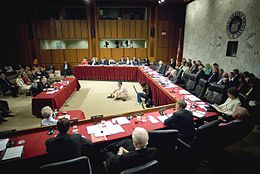
Back لجنة كونغرس الولايات المتحدة Arabic Comissió del Congrés dels Estats Units Catalan Kongressausschuss German کمیتههای کنگره ایالات متحده آمریکا Persian Komisje Kongresu Stanów Zjednoczonych Polish 美国国会委员会 Chinese


| This article is part of a series on the |
| United States Senate |
|---|
 |
| History of the United States Senate |
| Members |
|
|
| Politics and procedure |
| Places |
A congressional committee is a legislative sub-organization in the United States Congress that handles a specific duty (rather than the general duties of Congress). Committee membership enables members to develop specialized knowledge of the matters under their jurisdiction. As "little legislatures", the committees monitor ongoing governmental operations, identify issues suitable for legislative review, gather and evaluate information, and recommend courses of action to their parent body. Woodrow Wilson once wrote, "it is not far from the truth to say that Congress in session is Congress on public exhibition, whilst Congress in its committee rooms is Congress at work."[1] It is not expected that a member of Congress be an expert on all matters and subject areas that come before Congress.[2] Congressional committees provide valuable informational services to Congress by investigating and reporting about specialized subjects.
Congress divides its legislative, oversight, and internal administrative tasks among approximately 200 committees and subcommittees. Within assigned areas, these functional subunits gather information; compare and evaluate legislative alternatives; identify policy problems and propose solutions; select, determine, and report measures for full chamber consideration; monitor executive branch performance (oversight); and investigate allegations of wrongdoing.[3] The investigatory functions have always been a key role. In the tabling and wording of new law, procedures such as the House discharge petition process (the process of bringing a bill onto the floor without a committee report or mandatory consent from its leadership) are so laborious and technical that committees, today, dominate the draftsmanship and honing of the detail of many bills laid before Congress. Of the 73 discharge petitions submitted to the full House from 1995 through 2007, only one was successful in securing a definitive yea-or-nay vote for a bill.[4]
The growth in autonomy and overlap of committees has fragmented the power of the Senate and of the House. This dispersion of power may, at times, weaken the legislative branch relative to the other two branches of the federal government, the executive and the judiciary. In his often cited article History of the House of Representatives, written in 1961, American scholar George B. Galloway (1898–1967) wrote: "In practice, Congress functions not as a unified institution, but as a collection of semi-autonomous committees that seldom act in unison." Galloway went on to cite committee autonomy as a factor interfering with the adoption of a coherent legislative program.[5] Such autonomy remains a characteristic feature of the committee system in Congress today.
- ^ Woodrow Wilson, "Congressional Government", 1885, quoted in the JCOC Final Report. Archived December 27, 2006, at the Wayback Machine
- ^ English (2003), pp. 46–47
- ^ Committee Types and Roles Archived 2010-04-23 at the Wayback Machine, Congressional Research Service, April 1, 2003
- ^ Source on discharge petitions since 1997: Beginning with the 105th Congress, the House Clerk lists discharge petitions per Congress at its website,
- ^ George B. Galloway, History of the House of Representatives (New York: Thomas Y. Crowell, 1961), pp. 99–100.